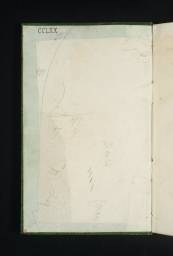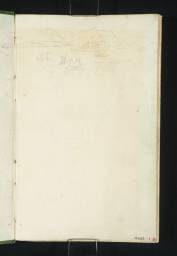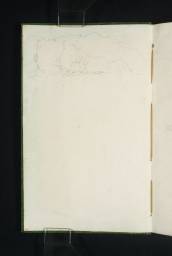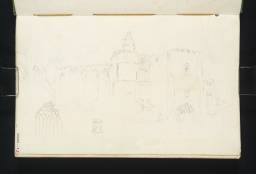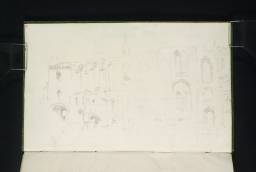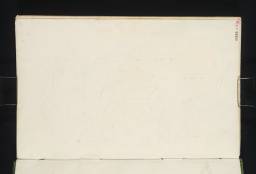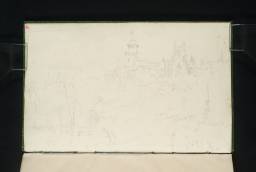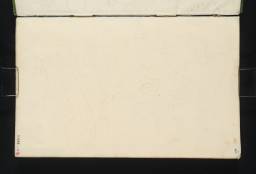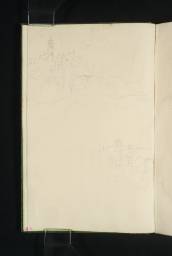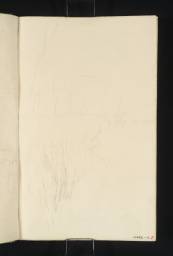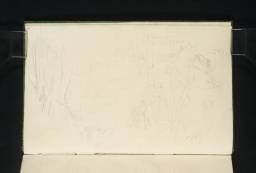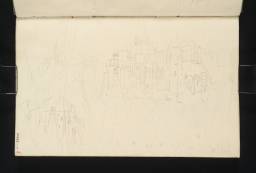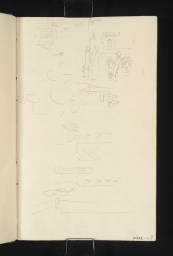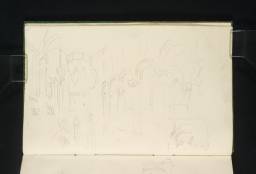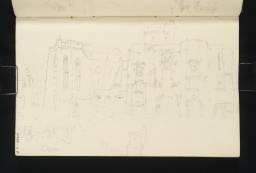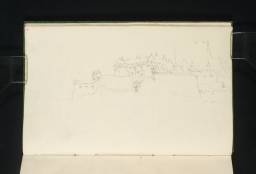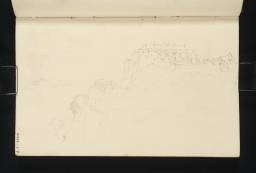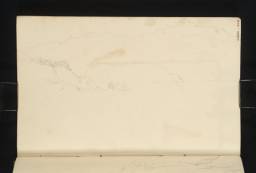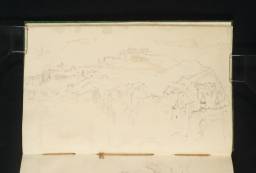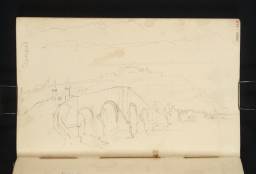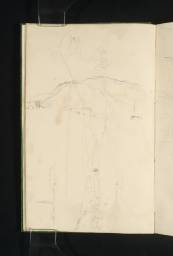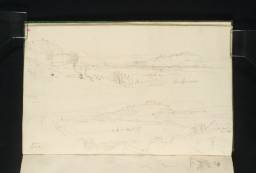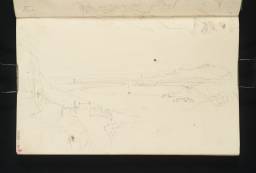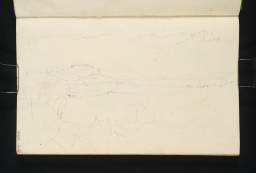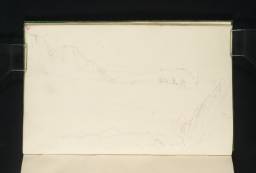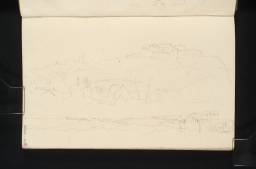Turner Bequest CCLXX
Sketchbook bound in green parchment-covered boards, inscribed in pencil on the front cover ‘CCLXX’ top left, and stamped in black ‘CCLXX’ top right. Inscribed in pencil by ?Turner on the back cover ‘Scott | Stirling and the West’ bottom inverted, blindstamped with the Turner Bequest stamp bottom right inverted.
Sketchbook made in Scotland. 92 leaves of white wove paper of four different batches. One batch made by Alexander Cowman and Son at Valleyfield Mill in Pennicuik, Midlothian, watermarked ‘[COW]AN & SON | [VALLE]YFIELD | [1]827’, and three batches of Whatman paper made by the Hollingworth brothers at Turkey Mill in Maidstone, Kent. One batch is watermarked ‘J WHATMAN | TURKEY MILLS | 1829’, another is watermarked ‘[WH]ATMAN | [TURKE]Y MILL | [18]28’, and the third has been dated 1827 but is not watermarked.
Approximate paper size: 125 x 201 mm
Numbered ‘187’ as part of the Turner Schedule in 1854 and endorsed by the executors of the Turner Bequest on the inside back cover (D41083).
Sketchbook made in Scotland. 92 leaves of white wove paper of four different batches. One batch made by Alexander Cowman and Son at Valleyfield Mill in Pennicuik, Midlothian, watermarked ‘[COW]AN & SON | [VALLE]YFIELD | [1]827’, and three batches of Whatman paper made by the Hollingworth brothers at Turkey Mill in Maidstone, Kent. One batch is watermarked ‘J WHATMAN | TURKEY MILLS | 1829’, another is watermarked ‘[WH]ATMAN | [TURKE]Y MILL | [18]28’, and the third has been dated 1827 but is not watermarked.
Approximate paper size: 125 x 201 mm
Numbered ‘187’ as part of the Turner Schedule in 1854 and endorsed by the executors of the Turner Bequest on the inside back cover (D41083).
Accepted by the nation as part of the Turner Bequest 1856
Exhibition history
References
This is one of a group of sketchbooks that Turner used during his tour of Scotland in 1831, conducted to collect material to illustrate a new edition of Sir Walter Scott’s Poetical Works. It was probably bought in Scotland1 and was first used in either Dumbarton or Stirling, from where Turner set off for the west of Scotland to see the Highlands and Western Isles. The name of the book derives from the inscription in pencil on the back cover, probably in Turner’s hand, that reads ‘Scott | Stirling and the West’. For more information on the tour see Tour of Scotland for Scott’s Poetical Works 1831 Tour Introduction.
Although the majority of sketches can be dated firmly to late August and early September 1831, a question about the dating of this sketchbook is raised by a sketch of Stirling that includes the New Bridge, the construction of which did not begin until September 1831, and which was not completed until 1833 (Tate D26465; Turner Bequest CCLXX 15a). Either Turner made the sketch in 1831 and added this detail three years later, or he brought this sketchbook back to Stirling on his return visit in 1834. Although there is no obvious sign that the New Bridge is a later addition to the sketch it would have been strange for the artist to have left several pages in the sketchbook blank in 1831 when other leaves are so crowded with sketches. While there is therefore the possibility that some of the sketches in the book could have been made in 1834, the present author believes that it is unlikely. As the possibility of Turner making a few sketches in 1834 of places he had also visited in 1831 does not disrupt the rest of the sketchbook it has been assumed that the whole book belongs to 1831.
Turner made his first sketches in this book at Queensferry (folio 1; D26436) on his way to Dunfermline (folio 3 verso; D26441), before heading west along the Firth of Forth to Stirling (folio 13; D26460), a journey recorded in the Loch Long sketchbook (Tate D26619–D26666; D41131–D41132 complete; Turner Bequest CCLXXI). He later referred to his sketches of Stirling (Tate D26460; Turner Bequest CCLXX 13) and Dunfermline (Tate D26441; Turner Bequest CCLXX 3a) as the basis for watercolours painted to illustrate Scott’s Prose Works: Dunfermline circa 1834–5 (private collection) and Stirling circa 1834–5 (Glasgow Museums).2
There are no sketches to record the journey from Stirling to Dumbarton; a curious omission as he must have passed through Glasgow without making any drawings. He took up his pencil again at Dumbarton on the Clyde, making a number of sketches of Dumbarton Rock and Castle (Tate D26577; Turner Bequest CCLXX 71a) which would contribute to the design of his watercolour, Dumbarton Castle circa 1833 (whereabouts unknown),3 engraved for Sir Walter Scott’s Prose Works. From here he set off to explore the lochs to the north and some of the islands of the Southern Hebrides. This part of Turner’s tour has been reconstructed by David Wallace-Hadrill and Janet Carolan, who suggested in an unpublished essay that suggest that Turner took three steamboat tours from the Clyde.4
The first tour was to Loch Lomond, Loch Katrine and Loch Achray. It began at Balloch north of Dumbarton, from where Turner boarded a steamer to the head of Loch Lomond via Luss on the western shore (Tate D26480; Turner Bequest CCLXX 23). From here it steamed south, dropping off passengers at Inversnaid, from where they took ponies along the north bank of Loch Arklet to Stonachlachar on Loch Katrine. Turner then boarded another boat which brought him to the east end of the loch and the Trossachs, which he passed through to reach the western end of Loch Achray. This is probably as far as he got before returning via the same route, though it has been suggested that he may have gone as far east as Callander (Tate D26561; Turner Bequest CCLXX 63a). However, this is more likely to have been saved for his 1834 tour.
The purpose of this journey was to sketch views to be painted as illustrations to the Lady of the Lake volume of Scott’s Poetical Works. Discussions between the poet and his publisher, Robert Cadell, about the selection of subjects to be illustrated for the frontispiece and vignette raised a number of possibilities,5 and it was not certain when Turner left for the Highlands which subjects he was to illustrate. The two subjects selected were Loch Katrine circa 1832 (watercolour, British Museum),6 and Loch Achray circa 1832 (Yale Center for British Art, Paul Mellon Collection),7 both based on sketches in this book (Tate D26528, D26532; Turner Bequest CCLXX 47, 49 respectively).
The second steamboat tour was advertised in the Glasgow Courier on 10 June 1831 as a journey by the St Catherine steamboat from Glasgow. It went halfway up Loch Long and to the head of Loch Goil (Tate D26471; Turner Bequest CCLXX 18a), followed by a coach to St Catherine’s on the east shore of Loch Fyne (Tate D26466; Turner Bequest CCLXX 16) and a ferry across the loch to Inveraray (Tate D26473; Turner Bequest CCLXX 19a).8 Sketches in the present book and the Loch Long sketchbook (D26619–D26666; D41131–D41132 complete; Turner Bequest CCLXXI) record this as Turner’s outward journey. However, he returned by a different route, which took him east by road from Cairndow (Tate D26475; Turner Bequest CCLXX 20a) via Rest and be Thankful and Glen Croe (Tate D26551; Turner Bequest CCLXX 58a) to Ben Arthur (Tate D26500; Turner Bequest CCLXX 33) which he climbed before descending to the head of Loch Long and going to the Clyde by boat.
The third steamboat tour was to the island of Islay. According to the Glasgow Courier, the Maid of Islay No.1 left Broomielaw in Glasgow on Tuesday and Thursday mornings and made its way to the mouth of the Clyde, rounding the northern side of the Isle of Bute, going through the Kyles of Bute and landing at East Loch Tarbert on the Kintyre Peninsula. The passengers then crossed the peninsula, before boarding another ferry at West Tarbert to continue their journey to Port Askaig on Islay. Turner made sketches from the ferry (see folio 15; D26464 for references) and numerous sketches of Islay, especially of Finlaggan Castle (folio 70 verso; D26575).
From Islay Turner returned to East Loch Tarbert and from there made his way to Inveraray, heading north by land to Loch Awe, which he crossed before continuing north to the southern shore of Loch Etive. Here he took up the Staffa sketchbook (D26748–D26834; D26836–D26935; D41086 complete; Turner Bequest CCLXXIII) and sketched Dunstaffanage and Dunollie Castles on his way to Oban.9 This was the base for Turner’s travels around the Western Isles. Having sketched the town and environs, and the nearby island of Kerrera (with the romantic ruins of Gylen Castle), he took a boat to Skye. He then passed through the Sound of Mull where he had his first opportunity to sketch the ruined castles of Duart, Ardtornish and Aros in the Sound of Mull no.1 (Tate D26936–D26948; D26950–D26954; D41019–D41020 complete; Turner Bequest CCLXXIV) and the Sound of Mull no.2 sketchbooks (Tate D26955–D26965; D41021–D41022 complete; Turner Bequest CCLXXV).
Landing at Advarsar on the eastern shore of the island, Turner took up the Stirling and West sketchbook once again, making several rough sketches of Castle Camus (Knock Castle) (Tate D26590; Turner Bequest CCLXX 78), before heading west to Dun Sgathaich Castle at Tokavaig (Tate D26608; Turner Bequest CCLXX 87a) where he crossed Loch Slapin to Straithaird and went onto Elgol. From Elgol he took a boat on Loch Scavaig to reach the entrance to Loch Coruisk, which he sketched from the mountain of Sgurr na Stri (folio 38 verso; D26511) for the watercolour, Loch Coriskin 1831 (The National Gallery of Scotland),10 which was engraved as the frontispiece to the Lord of the Isles volume of Scott’s Poetical Works.
From Elgol Turner went north-east around the head of Loch Slapin and onto Broadford. He sketched Castle Maol at Kyleakin, before boarding a boat that took him through the Kyles of Rhea on his way to Tobermory on Mull. This is where he put away the Stirling and West sketchbook, taking up the Staffa sketchbook first, then the Fort Augustus sketchbook (D26966–D27045 complete; Turner Bequest CCLXXVI), followed by the Inverness sketchbook (Tate D27046–D27225; D41038–D41039 complete; Turner Bequest CCLXXVII) and a group of loose sheets (Tate D12109, D34001, D34002, D34791–D34794, D34796, D34797, D34836, D34842–D34849, D34857, D34858, D40396; Turner Bequest CLIV K; CCCXLI a 284, 284; CCCLXIV d 324–327, 329, 330, 353, 357–361v, 369, 370, 370v). He used these sheets to record his visit to Staffa, and his journey north via Loch Linnhe to Glencoe and onto Fort William, Fort Augustus, Inverness, The Black Isle, Elgin and Aberdeen.
Although there are sequences of sketches in order in the sketchbook, Turner was not careful about using his book from beginning to end in chronological order. Having carelessly used the sketchbook from the front and the back, and filled in pages in the middle until it was about half full, Turner then began filling in the blank pages and blank spaces on half-used sheets. He also used four sketchbooks alongside it: the Loch Long and Staffa sketchbooks, and the two Sound of Mull books. Turner’s return to the Loch Long book, which he first used before opening the present book, was probably just to fill in blank pages. It is less certain why he abandoned the Stirling and the West book for a time to use the Staffa sketchbook and the two Sound of Mull sketchbooks.
Turner’s approach to sketching varied throughout the present sketchbook from the careful architectural studies of Dunfermline and the detailed landscape views of Stirling, to more rapid but still detailed landscape views (e.g. Tate D26509; Turner Bequest CCLXX 37a), sketches that capture the character of a landscape like the Trossachs (e.g. Tate D26488; Turner Bequest CCLXX 27), and quicker diagrammatic or outline sketches of hill profiles and the shape of distant islands (e.g. Tate D26560; Turner Bequest CCLXX 67).
Unlike the drawing in the little Sound of Mull books, for example, where rough sketches were made quickly one after another from the deck of a boat, the majority of sketches in the Stirling and the West book were treated as individual efforts, even when they repeated a view. Turner drew with a quick but confident and steady hand, making sketches that describe landscape accurately and capture the character of ragged rocks, romantic ruins and impressive distant peaks.
Many pages carry multiple sketches – up to five or six – sometimes as part of a sequence (e.g. Tate D26599; Turner Bequest CCLXX 83), though on occasion made at different stages of his journey (e.g. Tate D26590; Turner Bequest CCLXX 78). Certain sketches have therefore been hard to identify, although there are often inscriptions, and Turner’s accuracy when depicting ruins or the shapes of islands, hills and headlands are a great help. As mentioned above, a number of the sketches contributed towards finished watercolours, but almost all are of interest, capturing the appearance of the Highlands and Islands with great detail, and recording Turner’s response to the landscape. While Finberg made some progress with identifications (often deciphering Turner’s notes and inscriptions), subsequent scholars, especially David Wallace-Hadrill and Janet Carolan (who proposed the route suggested above but did not publish all of their work), made many further discoveries and almost all of the sketches have now been identified.
David Wallace-Hadrill and Janet Carolan, ‘Turner Round the Clyde and in Islay – 1831’, 1991, Tate catalogue files.
Wilton 1979, p.429 no.1085; the sketch was identified by David Wallace-Hadrill and Janet Carolan, ‘Turner Round the Clyde and In Islay – 1831’, 1991, Tate catalogue files, folio 4.
How to cite
Thomas Ardill, ‘Stirling and the West sketchbook 1831’, sketchbook, July 2010, in David Blayney Brown (ed.), J.M.W. Turner: Sketchbooks, Drawings and Watercolours, Tate Research Publication, December 2012, https://www

